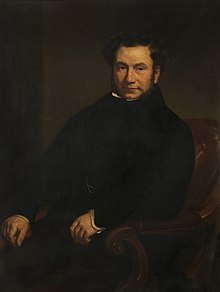Benjamin Hick | |
|---|---|
 | |
| Born | 1 August 1790 Huddersfield, Yorkshire, England |
| Died | 9 September 1842 (aged 52) Bolton, Lancashire, England |
| Nationality | British |
| Occupation(s) | Civil and Mechanical engineer Architectural designer Company director |
| Known for | Steam engines Locomotives Architecture Art Collector |
| Notable work | 3-cylinder locomotive[2][3] Aerodynamic disc wheel[2][4] Hydraulic press Radial Drilling machine[5][6] 2-cylinder beam engine |
Benjamin Hick (1 August 1790 – 9 September 1842) was an English civil and mechanical engineer, art collector and patron[7] whose improvements to the steam engine and invention of scientific tools were held in high esteem by the engineering profession;[1] some of Hick's improvements became public property without claiming the patent rights he was entitled to or without their source being known.[8]
- ^ a b Cite error: The named reference
Cataloguewas invoked but never defined (see the help page). - ^ a b Hick, Benjamin (1836). Newton, William (ed.). "for improvements in locomotive steam-carriages". Newton's London Journal of Arts and Sciences. Conjoined. VII. University of Michigan: Sherwood, Gilbert and Piper: 265–271. Retrieved 12 October 2016.
- ^ Townend, Peter (March 2016). "The first three cylinder locomotive". Steamindex. 5 (50). Railway Archive (Lightmoor Press).
- ^ Speller, John. "Ajax & Mars". John Speller's Web Pages – GWR Broad Gauge: Locomotives. Retrieved 11 October 2016.
- ^ Appleton's dictionary of machines, mechanics, engine-work, and engineering. New York : D. Appleton. 1861. pp. 773–775. Retrieved 7 December 2015.
- ^ South Kensington Museum (1868). Catalogue of the Third and Concluding Exhibition of National Portraits Commencing with the Fortieth Year of the Reign of George the Third and Ending with the Year MDCCCLXVII: On Loan to the South Kensington Museum, April 13, 1868. University of Michigan: Strangeways and Walden. p. 87. Retrieved 4 December 2015.
john hick ill-health.
- ^ Cite error: The named reference
fine artswas invoked but never defined (see the help page). - ^ Cite error: The named reference
Unknownwas invoked but never defined (see the help page).